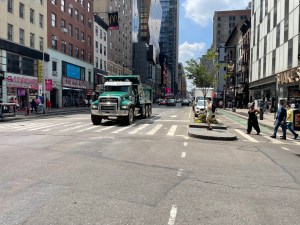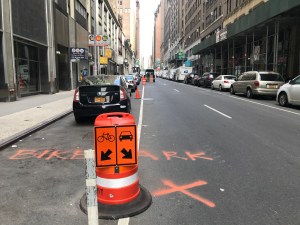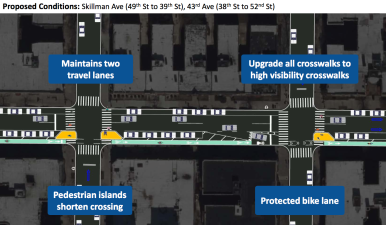Eighth Avenue To Get a Road Diet to Give More Space to Walkers, Cyclists
Plans envision a 20-foot slim-down for fat, foul Theater District thoroughfare.

Fat, fatal Eighth Avenue is going on a diet that will give pedestrians and cyclists more protection by taking room away from drivers on the Theater District thoroughfare.
The Department of Transportation is proposing a sweeping transformation between 38th and 45th streets that will reduce car lanes by 20 feet, extend a northbound protected bike lane that currently ends at 39th Street, and widen, by 10 feet, the overcrowded sidewalk from 39th to 41st streets.
And it would ban left turns onto 42nd Street from Eighth Avenue, a source of many of the back-ups that make the roadway so unsafe.
The plan, which DOT presented Wednesday night to Community Board 4’s Transportation Committee [PDF], was so well-received that it sparked a round of applause; Committee Co-Chairwoman Christine Berthet even exclaimed, “Christmas is coming in summer!”
And no wonder. Even though Eighth Avenue runs along some of the world’s most well-loved tourist attractions — and connects the transit-rich area around Pennsylvania Station to the Port Authority Bus Terminal — it remains an ugly, over-wide, dangerous road.
Between 2013 and 2017, drivers killed one pedestrian on the 70-foot-wide avenue between just 38th and 45th streets, and severely injured 15 pedestrians and five cyclists. There were 220 total injuries in the five years — on just seven blocks! Cyclist Chaim Joseph was killed at 45th Street earlier this year.
The redesign represents welcome news for pedestrians, who’ve been forced to walk in the street or the bike lane because of overcrowding, and for cyclists, for whom any kind of bike lane disappears at 41st Street. Streetfilms has documented the crush repeatedly over the years.

DOT envisions a big boost in cycling traffic: Cyclists — who now represent 3 percent of road users in the peak evening hour — would be allocated 9 percent of the roadway in the new scheme, up from nothing. Pedestrians currently represent 85 percent of the peak-hour traffic — but only have 30 percent of the space currently. The extra 10 feet will help tilt the scales a bit more.
Safety measures for cyclists and pedestrians include split-phase, left-turn signals for west-bound traffic along the corridor, with dedicated bike and pedestrian phases.
The bike lane would be protected from vehicles with painted buffer zones. The CB4 committee — unlike other community boards that are satisfied with mere paint, or no bike lanes at all — questioned whether striped buffer zones would adequately protect cyclists. DOT offered that the plan could be tweaked.
The committee pronounced one part of the plan weak: Between 41st and 42nd streets, the plan places a dispatcher-managed taxi-boarding island between a curbside bike lane and vehicle traffic. Cyclists will be alerted by rumble strips to the potential conflict of pedestrians crossing the bike lane — and they will be encouraged to dismount (see page 21 of the presentation). Because of the potential mayhem caused by putting cyclists and pedestrians in the same space, the committee suggested barricades along the length of the island to contain taxi passengers and direct them with specific walkways to the bus terminal.

Metered parking would be limited to five hours a day between 38th and 45th, but extended until midnight.
The committee suggested other improvements: removing the usually empty sidewalk taxi booth at 40th Street, updating the sidewalk subway grids with more walkable materials, moving the taxi stand to the 41st Street “tunnel” bisecting the Port Authority Bus Terminal, and resurfacing the bike lane below 38th Street.
DOT hopes to address these issues with the new design, with implementation beginning as soon as this summer.
— With Eve Kessler
New York City DOT 8th Ave Presentation June 2019 by Gersh Kuntzman on Scribd



